Liang Wu
Enhanced Whole Page Optimization via Mixed-Grained Reward Mechanism-Adapted Language Models
Jun 10, 2025Abstract:Optimizing the presentation of search and recommendation results is crucial to enhancing user experience and engagement. Whole Page Optimization (WPO) plays a pivotal role in this process, as it directly influences how information is surfaced to users. While Pre-trained Large Language Models (LLMs) have demonstrated remarkable capabilities in generating coherent and contextually relevant content, fine-tuning these models for complex tasks like WPO presents challenges. Specifically, the need for extensive human-annotated data to mitigate issues such as hallucinations and model instability can be prohibitively expensive, especially in large-scale systems that interact with millions of items daily. In this work, we address the challenge of fine-tuning LLMs for WPO by using user feedback as the supervision. Unlike manually labeled datasets, user feedback is inherently noisy and less precise. To overcome this, we propose a reward-based fine-tuning approach, PageLLM, which employs a mixed-grained reward mechanism that combines page-level and item-level rewards. The page-level reward evaluates the overall quality and coherence, while the item-level reward focuses on the accuracy and relevance of key recommendations. This dual-reward structure ensures that both the holistic presentation and the critical individual components are optimized. We validate PageLLM on both public and industrial datasets. PageLLM outperforms baselines and achieves a 0.44\% GMV increase in an online A/B test with over 10 million users, demonstrating its real-world impact.
Stability-based Generalization Analysis of Randomized Coordinate Descent for Pairwise Learning
Mar 03, 2025
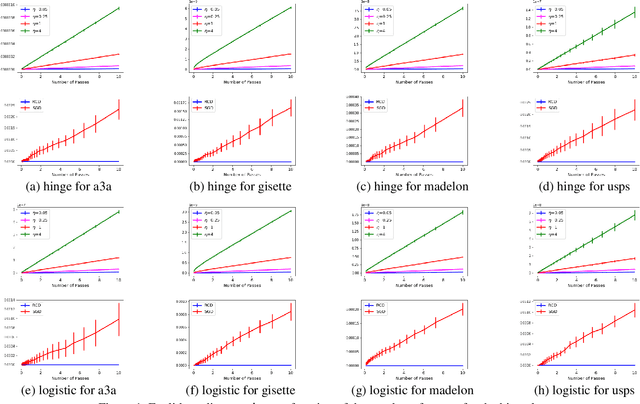
Abstract:Pairwise learning includes various machine learning tasks, with ranking and metric learning serving as the primary representatives. While randomized coordinate descent (RCD) is popular in various learning problems, there is much less theoretical analysis on the generalization behavior of models trained by RCD, especially under the pairwise learning framework. In this paper, we consider the generalization of RCD for pairwise learning. We measure the on-average argument stability for both convex and strongly convex objective functions, based on which we develop generalization bounds in expectation. The early-stopping strategy is adopted to quantify the balance between estimation and optimization. Our analysis further incorporates the low-noise setting into the excess risk bound to achieve the optimistic bound as $O(1/n)$, where $n$ is the sample size.
R-CoT: Reverse Chain-of-Thought Problem Generation for Geometric Reasoning in Large Multimodal Models
Oct 23, 2024



Abstract:Existing Large Multimodal Models (LMMs) struggle with mathematical geometric reasoning due to a lack of high-quality image-text paired data. Current geometric data generation approaches, which apply preset templates to generate geometric data or use Large Language Models (LLMs) to rephrase questions and answers (Q&A), unavoidably limit data accuracy and diversity. To synthesize higher-quality data, we propose a two-stage Reverse Chain-of-Thought (R-CoT) geometry problem generation pipeline. First, we introduce GeoChain to produce high-fidelity geometric images and corresponding descriptions highlighting relations among geometric elements. We then design a Reverse A&Q method that reasons step-by-step based on the descriptions and generates questions in reverse from the reasoning results. Experiments demonstrate that the proposed method brings significant and consistent improvements on multiple LMM baselines, achieving new performance records in the 2B, 7B, and 8B settings. Notably, R-CoT-8B significantly outperforms previous state-of-the-art open-source mathematical models by 16.6% on MathVista and 9.2% on GeoQA, while also surpassing the closed-source model GPT-4o by an average of 13% across both datasets. The code is available at https://github.com/dle666/R-CoT.
Merging Multiple Datasets for Improved Appearance-Based Gaze Estimation
Sep 02, 2024Abstract:Multiple datasets have been created for training and testing appearance-based gaze estimators. Intuitively, more data should lead to better performance. However, combining datasets to train a single esti-mator rarely improves gaze estimation performance. One reason may be differences in the experimental protocols used to obtain the gaze sam-ples, resulting in differences in the distributions of head poses, gaze an-gles, illumination, etc. Another reason may be the inconsistency between methods used to define gaze angles (label mismatch). We propose two innovations to improve the performance of gaze estimation by leveraging multiple datasets, a change in the estimator architecture and the intro-duction of a gaze adaptation module. Most state-of-the-art estimators merge information extracted from images of the two eyes and the entire face either in parallel or combine information from the eyes first then with the face. Our proposed Two-stage Transformer-based Gaze-feature Fusion (TTGF) method uses transformers to merge information from each eye and the face separately and then merge across the two eyes. We argue that this improves head pose invariance since changes in head pose affect left and right eye images in different ways. Our proposed Gaze Adaptation Module (GAM) method handles annotation inconsis-tency by applying a Gaze Adaption Module for each dataset to correct gaze estimates from a single shared estimator. This enables us to combine information across datasets despite differences in labeling. Our experi-ments show that these innovations improve gaze estimation performance over the SOTA both individually and collectively (by 10% - 20%). Our code is available at https://github.com/HKUST-NISL/GazeSetMerge.
Understanding and Modeling Job Marketplace with Pretrained Language Models
Aug 08, 2024Abstract:Job marketplace is a heterogeneous graph composed of interactions among members (job-seekers), companies, and jobs. Understanding and modeling job marketplace can benefit both job seekers and employers, ultimately contributing to the greater good of the society. However, existing graph neural network (GNN)-based methods have shallow understandings of the associated textual features and heterogeneous relations. To address the above challenges, we propose PLM4Job, a job marketplace foundation model that tightly couples pretrained language models (PLM) with job market graph, aiming to fully utilize the pretrained knowledge and reasoning ability to model member/job textual features as well as various member-job relations simultaneously. In the pretraining phase, we propose a heterogeneous ego-graph-based prompting strategy to model and aggregate member/job textual features based on the topological structure around the target member/job node, where entity type embeddings and graph positional embeddings are introduced accordingly to model different entities and their heterogeneous relations. Meanwhile, a proximity-aware attention alignment strategy is designed to dynamically adjust the attention of the PLM on ego-graph node tokens in the prompt, such that the attention can be better aligned with job marketplace semantics. Extensive experiments at LinkedIn demonstrate the effectiveness of PLM4Job.
Generalized Low-Rank Matrix Completion Model with Overlapping Group Error Representation
Jul 11, 2024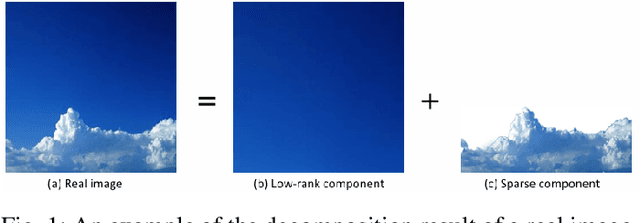
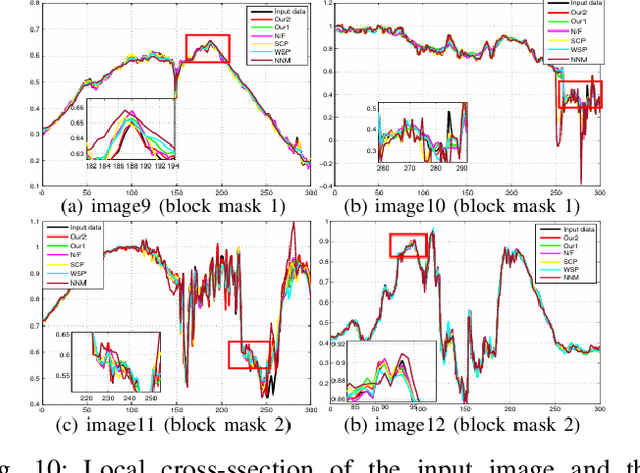
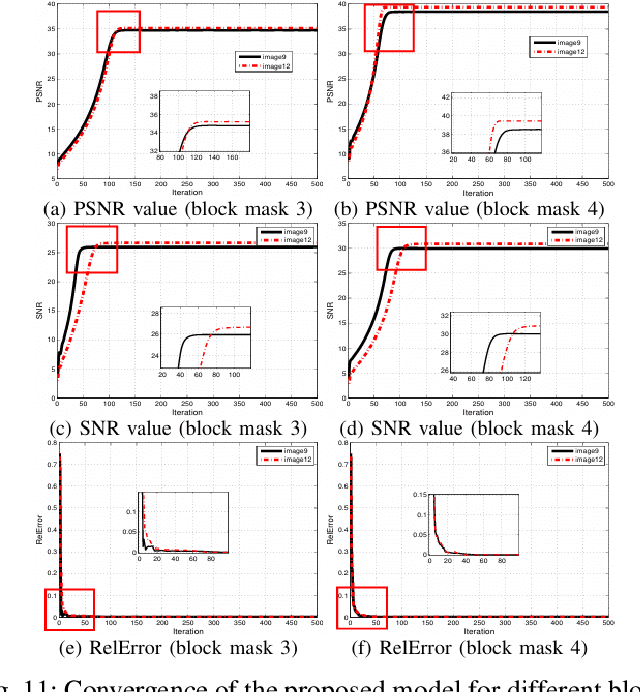

Abstract:The low-rank matrix completion (LRMC) technology has achieved remarkable results in low-level visual tasks. There is an underlying assumption that the real-world matrix data is low-rank in LRMC. However, the real matrix data does not satisfy the strict low-rank property, which undoubtedly present serious challenges for the above-mentioned matrix recovery methods. Fortunately, there are feasible schemes that devise appropriate and effective priori representations for describing the intrinsic information of real data. In this paper, we firstly model the matrix data ${\bf{Y}}$ as the sum of a low-rank approximation component $\bf{X}$ and an approximation error component $\cal{E}$. This finer-grained data decomposition architecture enables each component of information to be portrayed more precisely. Further, we design an overlapping group error representation (OGER) function to characterize the above error structure and propose a generalized low-rank matrix completion model based on OGER. Specifically, the low-rank component describes the global structure information of matrix data, while the OGER component not only compensates for the approximation error between the low-rank component and the real data but also better captures the local block sparsity information of matrix data. Finally, we develop an alternating direction method of multipliers (ADMM) that integrates the majorization-minimization (MM) algorithm, which enables the efficient solution of the proposed model. And we analyze the convergence of the algorithm in detail both theoretically and experimentally. In addition, the results of numerical experiments demonstrate that the proposed model outperforms existing competing models in performance.
ERD: Exponential Retinex decomposition based on weak space and hybrid nonconvex regularization and its denoising application
Jul 11, 2024
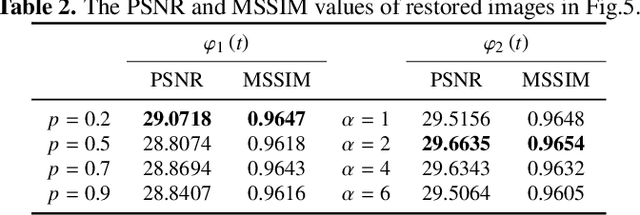
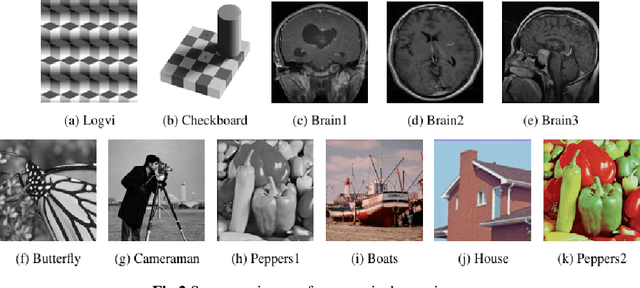

Abstract:The Retinex theory models the image as a product of illumination and reflection components, which has received extensive attention and is widely used in image enhancement, segmentation and color restoration. However, it has been rarely used in additive noise removal due to the inclusion of both multiplication and addition operations in the Retinex noisy image modeling. In this paper, we propose an exponential Retinex decomposition model based on hybrid non-convex regularization and weak space oscillation-modeling for image denoising. The proposed model utilizes non-convex first-order total variation (TV) and non-convex second-order TV to regularize the reflection component and the illumination component, respectively, and employs weak $H^{-1}$ norm to measure the residual component. By utilizing different regularizers, the proposed model effectively decomposes the image into reflection, illumination, and noise components. An alternating direction multipliers method (ADMM) combined with the Majorize-Minimization (MM) algorithm is developed to solve the proposed model. Furthermore, we provide a detailed proof of the convergence property of the algorithm. Numerical experiments validate both the proposed model and algorithm. Compared with several state-of-the-art denoising models, the proposed model exhibits superior performance in terms of peak signal-to-noise ratio (PSNR) and mean structural similarity (MSSIM).
StrucTexTv3: An Efficient Vision-Language Model for Text-rich Image Perception, Comprehension, and Beyond
Jun 04, 2024Abstract:Text-rich images have significant and extensive value, deeply integrated into various aspects of human life. Notably, both visual cues and linguistic symbols in text-rich images play crucial roles in information transmission but are accompanied by diverse challenges. Therefore, the efficient and effective understanding of text-rich images is a crucial litmus test for the capability of Vision-Language Models. We have crafted an efficient vision-language model, StrucTexTv3, tailored to tackle various intelligent tasks for text-rich images. The significant design of StrucTexTv3 is presented in the following aspects: Firstly, we adopt a combination of an effective multi-scale reduced visual transformer and a multi-granularity token sampler (MG-Sampler) as a visual token generator, successfully solving the challenges of high-resolution input and complex representation learning for text-rich images. Secondly, we enhance the perception and comprehension abilities of StrucTexTv3 through instruction learning, seamlessly integrating various text-oriented tasks into a unified framework. Thirdly, we have curated a comprehensive collection of high-quality text-rich images, abbreviated as TIM-30M, encompassing diverse scenarios like incidental scenes, office documents, web pages, and screenshots, thereby improving the robustness of our model. Our method achieved SOTA results in text-rich image perception tasks, and significantly improved performance in comprehension tasks. Among multimodal models with LLM decoder of approximately 1.8B parameters, it stands out as a leader, which also makes the deployment of edge devices feasible. In summary, the StrucTexTv3 model, featuring efficient structural design, outstanding performance, and broad adaptability, offers robust support for diverse intelligent application tasks involving text-rich images, thus exhibiting immense potential for widespread application.
Leveraging Foundation Model Automatic Data Augmentation Strategies and Skeletal Points for Hands Action Recognition in Industrial Assembly Lines
Mar 14, 2024



Abstract:On modern industrial assembly lines, many intelligent algorithms have been developed to replace or supervise workers. However, we found that there were bottlenecks in both training datasets and real-time performance when deploying algorithms on actual assembly line. Therefore, we developed a promising strategy for expanding industrial datasets, which utilized large models with strong generalization abilities to achieve efficient, high-quality, and large-scale dataset expansion, solving the problem of insufficient and low-quality industrial datasets. We also applied this strategy to video action recognition. We proposed a method of converting hand action recognition problems into hand skeletal trajectory classification problems, which solved the real-time performance problem of industrial algorithms. In the "hand movements during wire insertion" scenarios on the actual assembly line, the accuracy of hand action recognition reached 98.8\%. We conducted detailed experimental analysis to demonstrate the effectiveness and superiority of the method, and deployed the entire process on Midea's actual assembly line.
LinkSAGE: Optimizing Job Matching Using Graph Neural Networks
Feb 20, 2024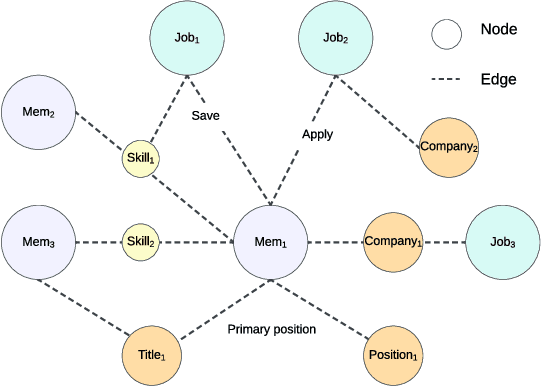

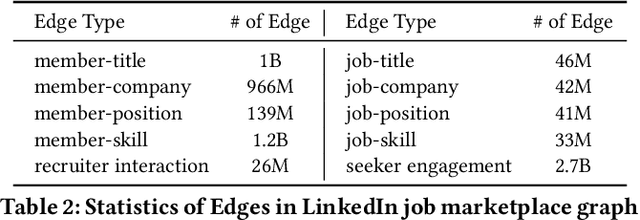

Abstract:We present LinkSAGE, an innovative framework that integrates Graph Neural Networks (GNNs) into large-scale personalized job matching systems, designed to address the complex dynamics of LinkedIns extensive professional network. Our approach capitalizes on a novel job marketplace graph, the largest and most intricate of its kind in industry, with billions of nodes and edges. This graph is not merely extensive but also richly detailed, encompassing member and job nodes along with key attributes, thus creating an expansive and interwoven network. A key innovation in LinkSAGE is its training and serving methodology, which effectively combines inductive graph learning on a heterogeneous, evolving graph with an encoder-decoder GNN model. This methodology decouples the training of the GNN model from that of existing Deep Neural Nets (DNN) models, eliminating the need for frequent GNN retraining while maintaining up-to-date graph signals in near realtime, allowing for the effective integration of GNN insights through transfer learning. The subsequent nearline inference system serves the GNN encoder within a real-world setting, significantly reducing online latency and obviating the need for costly real-time GNN infrastructure. Validated across multiple online A/B tests in diverse product scenarios, LinkSAGE demonstrates marked improvements in member engagement, relevance matching, and member retention, confirming its generalizability and practical impact.
 Add to Chrome
Add to Chrome Add to Firefox
Add to Firefox Add to Edge
Add to Edge